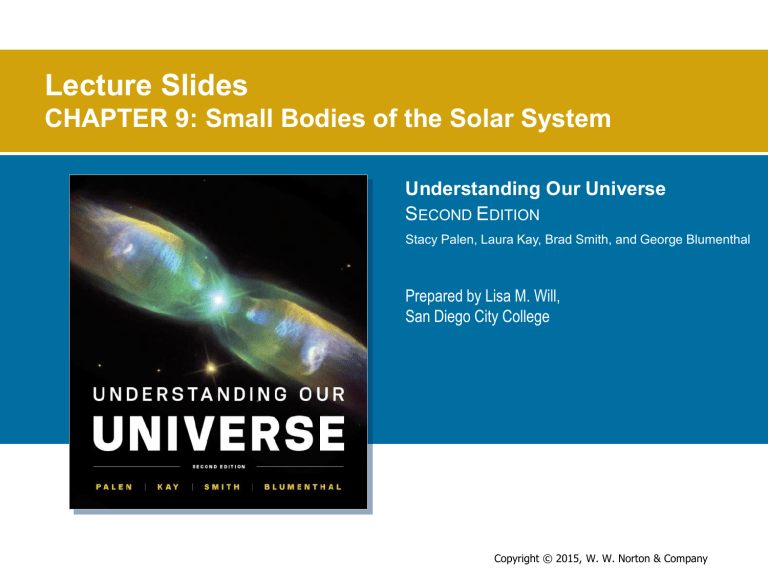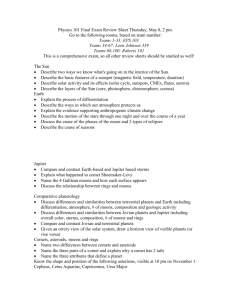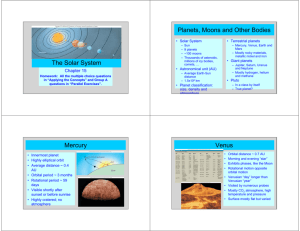Lecture Slides CHAPTER 9: Small Bodies of the Solar System S

Lecture Slides
CHAPTER 9: Small Bodies of the Solar System
Understanding Our Universe
S ECOND E DITION
Stacy Palen, Laura Kay, Brad Smith, and George Blumenthal
Prepared by Lisa M. Will,
San Diego City College
Copyright © 2015, W. W. Norton & Company
Small Bodies of the Solar System
There are a variety of small bodies in the solar system.
• Dwarf planets
• Moons
•
Asteroids
• Comets
• Kuiper Belt Objects
• Meteoroids
Planet vs. Dwarf Planet
A planet is an object that:
•
1. Pulls itself into a round shape.
• 2. Clears the area around its orbit.
•
3. Orbits a star.
Dwarf planets fail to meet definition #2.
There are five dwarf planets in our solar system.
• Four reside in the Kuiper Belt beyond Neptune’s orbit:
Pluto, Haumea, Makemake, and Eris.
• One is in the main asteroid belt: Ceres.
Pluto
Has five moons.
• The largest, Charon, is half of Pluto’s size!
Pluto is smaller than Earth’s Moon.
It’s orbit is eccentric, varying from 30-50 AU from the
Sun.
Solid rock/ice mixture.
Thin atmosphere
Pluto: We know a lot more now!
NASA’s New Horizons mission flew by Pluto in the summer of 2015 and now we know a LOT more about
Pluto and its moons.
Coming soon: a special lecture on Pluto, complete with amazing images from New Horizons!
Eris and Ceres
Eris is the most distant dwarf planet, more massive than
Pluto but similar in size.
Ceres used to be known as the largest asteroid.
We know more about Ceres, too, from NASA’s Dawn mission.
New Images of Ceres from NASA’s
Dawn Mission
Movie : Flight over Ceres
Moons
The four giant planets have several large moons.
Some are geologically active.
Relative sizes of some worlds in our
Solar System
Moons of Jupiter
The four Moons of Jupiter that Galileo was able to detect with his small telescope are known as the
“Galilean satellites” of Jupiter. Galileo watched them orbit Jupiter and established proof that the Earth is not at the center of everything!
They are, in order from closest to Jupiter to farthest:
Io (period: 1.77 days)
Europa (period: 3.55 days)
Ganymede (period: 7.15 days)
Callisto (period: 16.69 days)
Moons of Jupiter: Io
Io (closest moon to
Jupiter) is the most volcanically active object in the Solar
System!
Sulfur compounds and silicate magma.
No impact craters
Very young surface.
Class question:
What is causing Io’s volcanism?
Moons of Jupiter: Europa
Moons of Jupiter: Europa
Europa: Jupiter’s tidal heating allows for this moon to have a subsurface liquid water ocean.
Moons of Jupiter: Ganymede
Moons of Jupiter: Ganymede
Ganymede shows signs of gradually filled-in craters.
Its terrain shows evidence of a geologically active past.
Ganymede is the largest moon in the solar system .
Class Question
If Ganymede is larger than Mercury, why is it considered moon and not a planet?
A. Ganymede does not have an atmosphere.
B. Ganymede does not have rings.
C. Mercury is too small to be a planet itself.
D. Planets must orbit stars.
Moons of Jupiter: Callisto
Heavily cratered; does not appear to be geologically active.
Moons of Saturn: Enceladus
Enceladus (Saturn): parts of surface are young.
Experiences cryovolcanism, where the “magma” is water.
Moons of Saturn: Enceladus
Note “Tiger stripes”
Moons of Saturn: Enceladus (Water geysers!
What might be beneath the surface?)
Moons of Saturn: Titan
Titan is Saturn’s largest moon.
It has a thick, dense, nitrogen-rich atmosphere.
Facts of Titan
The Huygens probe
(launched from the Cassini spacecraft) revealed that
Titan has icy “rocks” and a soil rich with organic compounds.
Images were taken by the
Huygens probe as it decended.
Huygens descent movie
Titan: Presence of Methane
On Titan, methane appears to experience a cycle like rain on Earth, involving lakes and clouds. On Earth methane is a gas, but it is so cold on Titan that methane is a liquid!
Methane in the atmosphere is most likely renewed by active geology.
Moon of Neptune: Triton (not to be confused with Titan!)
Triton is a captured moon of Neptune.
Similar to Pluto.
Cantaloupe-like surface is a clue to its activity – possibly pits of slushy ice.
Its cryovolcanic activity involves geysers of nitrogen.
Moons: Characteristics
Jupiter’s Callisto, Uranus’s Umbriel, and many, many others show no sign of past geological activity.
Dark, heavily cratered surfaces from a long history of impacts.
Just like the planets, moons display a great variety of environments.
Asteroids
Most asteroids are in the asteroid belt between Mars and Jupiter.
Socalled “Near-
Earth” asteroids have orbits that cross that of Earth.
Asteroids: Features
Asteroids are small, rocky relics of the early Solar System.
Most are composed of rock or metal.
It is possible for them to have moons.
Spacecraft have visited several of them.
Asteroids: Phobos and Deimos
These are the two moons of Mars, Phobos and Deimos.
They are small, irregularly shaped, and composed of different materials than the Martian surface. => Possibly captured asteroids.
Asteroids: Phobos and Deimos (Cont.)
Asteroids: Phobos and Deimos (Cont.)
Comets
Comets: icy planetesimals that formed with the Solar
System.
Originate either in the
Kuiper Belt (beyond
Neptune) or the Oort
Cloud surrounding the
Solar System.
Comets: Short-period
Short-period comets:
•
Periods < 200 years.
• Near ecliptic plane.
• Mostly prograde orbits, close to circular or somewhat elongated.
• Origin = Kuiper Belt.
Comets: Long-period
Long-period comets:
•
Periods from 200 to millions of years.
• Prograde or retrograde orbits
• Large orbital inclinations, very elongated orbits
• Origin = Oort Cloud.
Comets: Solar Heating
When near the Sun, comets are “active.”
Sun heats the icy nucleus, forming:
• Coma (head)
• Ion tail
• Dust tail
Comets: Ion Tail Vs. Dust Tail
Ion tail is created by the solar wind interacting with ions of the nucleus.
Dust tail is created from solar wind and sunlight.
Comet tails point away from the Sun.
Comets: Naked Eye Object
Comets develop extended tails when in the inner solar system.
When the comet is simultaneously close to Sun and close to Earth, the comet may be a naked eye object from Earth.
Comets: Nucleus
The solid part is the nucleus.
Nucleus is an ice/rock mixture.
Often called “Dirty snowballs.” Most are very dark, however.
Size of nucleus ranges from a few dozen meters to several hundred kilometers.
Class Question
Short-period comets are associated with what class of objects?
A. Kuiper Belt objects
B. Terrestrial planets
C. The Oort Cloud
D. The giant planets
Class Question
Long-period comets are associated with what class of objects?
A. Kuiper Belt objects
B. Terrestrial planets
C. The Oort Cloud
D. The giant planets
Impacts: Timeline
Comet or asteroid impacts are infrequent, but devastating.
1908: Tunguska event was possibly the high-altitude explosion of an asteroid or comet.
Impacts: Timeline (Cont.)
In February 2013, a object with an estimated size of
10 meters exploded over Chelyabinsk, Russia.
Several impacts on Jupiter have been observed in recent years.
Impacts: Timeline (Cont.)
Impacts: Timeline (Cont.)
Impacts: Debris
Comet nucleus disintegration and asteroid collisions make debris.
Passing through cometary debris results in harmless meteor showers.
Most of this debris will burn up in the atmosphere.
Impacts: Meteorites
The vast majority of meteorites are pieces of asteroids that have fallen to Earth.
•
In space a meteorite is called a meteoroid.
• While passing through the atmosphere, it is a meteor.
Can use meteorites to date the age of the Solar
System (4.6 billion years).
A few meteorites are known to be from the Moon and
Mars.
Impacts: Stony Meteorites
Over 90% of meteorites are stony.
Can have round chondrules (chondrites) or not
(achondrites).
Most stony meteorites are silicates, but some have more carbon.
Impacts: Stony Meteorites (Cont.)
Impacts: Stony Meteorites (Cont.)
Impacts: Iron Meteorites
Iron meteorites have high concentrations of metal, with a melted and pitted appearance.
Stony-iron meteorites are a combination and are relatively rare.
Impacts: Iron Meteorites (Cont.)
Impacts: Iron Meteorites (Cont.)
Impacts: Mars Rovers’ Discovery
Our Mars rovers have discovered iron meteorites on the surface of Mars!
Chapter Summary
Small bodies in the Solar System include dwarf planets, moons, asteroids, comets, Kuiper Belt objects, and meteorites.
Moons of the outer solar system show great diversity of environments – composition, geological activity
Asteroids, comets, and meteorites yield samples of material that represent the history of the Solar
System.
AstroTour
Cometary Orbits
Click the image to launch the AstroTour Animation
(Requires an active Internet connection)
Nebraska Applet
Driving Through Snow
Click the image to launch the Nebraska Applet
(Requires an active Internet connection)
Understanding Our Universe
S ECOND E DITION
Stacy Palen, Laura Kay, Brad Smith, and George Blumenthal
Prepared by Lisa M. Will,
San Diego City College
This concludes the Lecture slides for
CHAPTER 9: Small Bodies of the Solar System wwnpag.es/uou2
Copyright © 2015, W. W. Norton & Company





